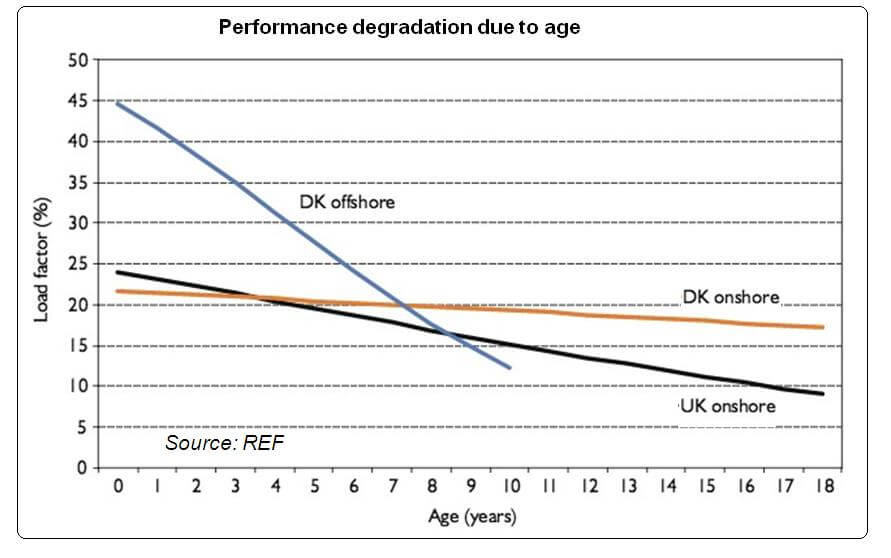Editor’s note: This article from Wind Energy Update is authored by Matilde Mereghetti. Wind energy Update promotes the Wind O&M Dallas conference that will be held this year from April 11 to 13.
Optimizing performance and reducing operation and maintenance (O&M) costs of aging plants has become a major challenge for the wind industry in U.S. and Europe, particularly in the countries and states that have been pioneers in wind installations.

In Europe alone, around 11 GW of installed wind energy capacity will come to an end of life by 2020, assuming a turbine lifespan of 20 years.
In Europe alone, around 11 GW of installed wind energy capacity will come to an end of life by 2020, assuming a turbine lifespan of 20 years. The European Wind Energy Association (EWEA) has forecast at least 76 GW will reach this point between 2020 and 2030.
O&M costs make up 20 to 25% of the total levelized cost per kWh produced over the lifetime of the turbine, according to the EWEA. O&M costs may represent only 10 to 15% of this cost for a relatively new turbine, but can increase to at least 20 to 35% by the end of the turbine’s lifetime.
As reliability decreases with the age of the turbine, scarcity of spare parts for certain older models or a general rise in parts replacement can cause O&M costs to surge.
“The biggest challenge now is to maintain the supply chain, including all the different components, also for older turbines, which implies understanding and recognizing the age of the machines. Some turbines have a life span of about 20 years and we are benchmarking 15 years, so in some cases this can justify a repower or an upgrade,” one large US plant operator told Wind Energy Update.
End of life turbine maintenance offer producers an opportunity to upgrade technology and increase production, industry experts said.
Higher returns
A study carried out in 2012 by the Renewable Energy Foundation outlined the decline in load factor, adjusted for wind availability, as turbines age. The study analyzed the performance of UK and Danish wind farms.
 The quality of maintenance, remote data analysis and upgrades play an important role in the performance of ageing assets. The wearing effects towards the end of a turbine’s lifetime can be well-managed with a solid underlying spare part concept and by leveraging proven remote diagnostics, Christopher Ulrich, Head of Product Lifecycle Management at Siemens Wind Service, said.
The quality of maintenance, remote data analysis and upgrades play an important role in the performance of ageing assets. The wearing effects towards the end of a turbine’s lifetime can be well-managed with a solid underlying spare part concept and by leveraging proven remote diagnostics, Christopher Ulrich, Head of Product Lifecycle Management at Siemens Wind Service, said.
Predictive technologies such as Condition Monitoring Systems (CMS), which allow forecasting components’ failure before they occur, play a key role in optimizing turbines’ performance and reducing O&M costs.
“Our data-driven remote diagnostics services (RDS) portfolio is the foundation for any advanced service setup that we operate on our customer’s wind farms – they will be of even higher importance to manage the costs of aging wind farms,” Ulrich said.
A wide range of upgrades can help optimize performance and increase the revenue stream of ageing wind farms, while minimizing long-term O&M costs.
“Modernization upgrades can help not only to extend the turbine’s lifetime but also to maintain the system integrity and performance on a high level throughout its lifetime,” Ulrich said.
Upgrades can improve reliability, performance and asset compliance, as well as extra safety features.
New ideas
Installing remote monitoring system and upgrading the electrical components of the turbine are key upgrades to increase reliability of wind turbines, says Rene Balle, Chief Technology Officer (CTO) at KK Wind Services.
Additional sensors such as an oil particle counter or a main bearing damage detector can extend the capabilities of the turbines’ diagnostics system. Other solutions, such as advanced offline oil filtering systems, have proven to improve the reliability of the hydraulic system.
Equipment manufacturers’ research and development teams are continuing to develop performance-improving features to be applied to turbine platforms throughout their lifetime.
Some solutions provide return on investment within two years, yielding results for ageing assets. Controller upgrades, such as Siemens’ High Wind Ride Through (HWRT), can optimize turbine performance in situations of extreme wind speed, reducing the number of turbine stoppages.
Planning pays
There is currently significant demand for performance improvement upgrades for turbines between 10 and 20 years old. Major upgrades may only make economic sense if they are performed more than three years or in some cases at least 10 years before the end of a turbine’s lifespan, due to higher capital expenditure (CAPEX).
Operators can prepare for wind turbine wear in the early stages of a turbine’s life through proper O&M assessments and condition monitoring, Balle said.
“There are more than 140,000 turbines that are older than five years and which capacity is above 560 kW. These conditions correspond to our criteria to decide when it makes sense to start upgrading a turbine,” he said.
Wind energy Update promotes the Wind O&M Dallas conference that will be held this year from April 11 to 13.
Filed Under: News, O&M




